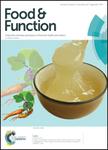版权所有:内蒙古大学图书馆 技术提供:维普资讯• 智图
内蒙古自治区呼和浩特市赛罕区大学西街235号 邮编: 010021

作者机构:Beijing Technol & Business Univ China Food Flavor & Nutr Hlth Innovat Ctr Beijing 100048 Peoples R China Beijing Technol & Business Univ Natl Soybean Proc Ind Technol Innovat Ctr Beijing 100048 Peoples R China
出 版 物:《FOOD & FUNCTION》 (Food. Funct.)
年 卷 期:2025年第16卷第3期
页 面:797-814页
核心收录:
学科分类:0710[理学-生物学] 0832[工学-食品科学与工程(可授工学、农学学位)] 08[工学]
基 金:National Key Research and Development Program of China [2021YFD2100402] National Key Research and Development Program of China
主 题:Tannins
摘 要:Cardiovascular diseases (CVD) represent a primary global health challenge. Poor dietary choices and lifestyle factors significantly increase the risk of developing CVD. Legumes, recognized as functional foods, contain various bioactive components such as active peptides, protease inhibitors, saponins, isoflavones, lectins, phytates, and tannins. Studies have demonstrated that several of these compounds are associated with the prevention and treatment of cardiovascular diseases, notably active peptides, saponins, isoflavones, and tannins. This review aims to analyze and summarize the relationship between bioactive compounds in legumes and cardiovascular health. It elaborates on the mechanisms through which active ingredients in legumes interact with risk factors for cardiovascular diseases, such as hypertension, hypercholesterolemia, endothelial dysfunction, and atherosclerosis. These mechanisms include, but are not limited to, lowering blood pressure, regulating lipid levels, promoting anticoagulation, enhancing endothelial function, and modulating TLR4 and NF-kappa B signaling pathways. Together, these mechanisms emphasize the potential of legumes in improving cardiovascular health. Additionally, the limitations of bioactive components in legumes and their practical applications, with the goal of fostering further advancements in this area were discussed.